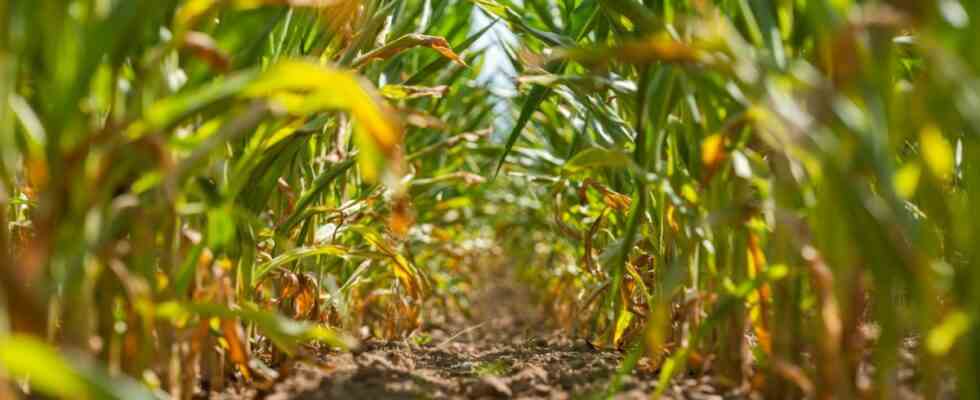The location? “Extraordinary,” says Artur Steinmann on the phone. According to his own words, the President of the Franconian Winegrowers Association and winegrowers in Sommerhausen (Würzburg district) experienced a similar drought summer in 1976. But now it is “even more extreme”, even in 2018 and 2019 it rained far too little. The result: while some winegrowers can currently hope for a good harvest because irrigation systems wash a few drops into the soil, others have to remove the grapes prematurely in order to at least save the vines. “Without water,” says Steinmann, “it doesn’t work.”
Not only the winegrowers and their vines are groaning under the persistent drought that has settled over Bavaria. Since May 2022, the German Weather Service (DWD) reported last week, the combination of too little precipitation and above-average temperatures and hours of sunshine have caused the soil in many places to dry out severely. And now the next problem is looming: The district office in Traunstein issues an advance warning for flooding on Thursday, according to forecasts by the DWD for Friday and Saturday – due to heavy rain in the region. “In addition, the soil can hardly absorb any precipitation due to the drought that has lasted for weeks. Increased surface water must therefore be expected,” it said. Irrespective of this, some arable farmers are already anticipating losses in yields. Their tractors are currently pulling long clouds of dust behind them in the fields, and the corn is hanging. Meadows glow burned brown in the sun instead of lush green.
Dry feet: Two women can stand on an island in the Sylvenstein reservoir near Lenggries in Upper Bavaria that has been exposed due to the lack of water.
(Photo: Peter Kneffel/dpa)
Fighting the heat: After a forest fire, a firefighter puts out embers (above). According to the district fire inspection Main-Spessart, almost three hectares of forest were affected by the fire.
(Photo: Benedict Rottmann/dpa)
The high risk of forest fires can also lead to precarious situations for forest dwellers such as deer.
(Photo: Lino Mirgeler/dpa)
The risk of forest fires has also been high recently. Air observers got on planes to look out for potential sources of fire, authorities warned of cigarette butts being flicked away. Nevertheless, more than 20,000 square meters of forest burned in the Schwandorf district: first on Wednesday evening trees in Nabburg were on fire, then at night a few kilometers further in Schwarzach. Firefighters were able to contain and eventually extinguish the fire. The cause and extent of damage were initially unclear.
The situation for Bavaria’s inland boatmen is also problematic. According to Bayernhafen, which operates the ports from Aschaffenburg to Passau, shipping traffic on the free-flowing section of the Danube between Vilshofen and Straubing has come to a virtual standstill due to extremely low water. On the other hand, the low water level of the Rhine is indirectly noticeable on the Main. “The ships heading towards the Rhine and North Sea ports take on significantly less cargo than usual or arrive from the Rhine with significantly less cargo,” says Managing Director Joachim Zimmermann. The barges could only transport a quarter to a fifth of their capacity due to the lack of draft. The companies are therefore trying to shift freight to rail or road – although it takes around 150 trucks to replace a barge.
Sun lovers under pressure: The vines on the vineyards in Nordheim in the Lower Franconian district of Kitzingen generally like light and warmth. But they don’t get too much either.
(Photo: Karl-Josef Hildenbrand/dpa)
Fire hazard: Fire and smoke can be seen on a wheat field between Niedernberg and Großostheim in the Lower Franconian district of Miltenberg. A threshing machine probably caused flying sparks while threshing grain.
(Photo: Ralf Hettler/dpa)
Caution, poisonous: A bathing ban has been imposed for the quarry pond Breitengüßbach in the district of Bamberg. A carpet of blue-green algae is to blame. The bacteria can also harm people.
(Photo: Nicolas Armer/dpa)
A little rain alone will probably not eliminate the drought. The Franconian winegrowers have therefore been researching for a long time how winegrowing can be repositioned in times of climate change. “We urgently need more irrigation,” says Steinmann, otherwise it will not work in the future. After all: Franconian wine is not endangered. There will be less this year, says Steinmann, “but it will be good”.

